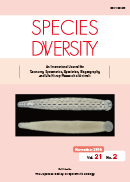Volume 21, Issue 2
Displaying 1-12 of 12 articles from this issue
- |<
- <
- 1
- >
- >|
-
2016Volume 21Issue 2 Pages 95-104
Published: November 25, 2016
Released on J-STAGE: February 03, 2017
Download PDF (757K) -
2016Volume 21Issue 2 Pages 105-110
Published: November 25, 2016
Released on J-STAGE: February 03, 2017
Download PDF (803K) -
2016Volume 21Issue 2 Pages 111-116
Published: November 25, 2016
Released on J-STAGE: February 03, 2017
Download PDF (993K) -
2016Volume 21Issue 2 Pages 117-125
Published: November 25, 2016
Released on J-STAGE: February 03, 2017
Download PDF (799K) -
2016Volume 21Issue 2 Pages 127-134
Published: November 25, 2016
Released on J-STAGE: February 03, 2017
Download PDF (1023K) -
2016Volume 21Issue 2 Pages 135-142
Published: November 25, 2016
Released on J-STAGE: February 03, 2017
Download PDF (1511K) -
2016Volume 21Issue 2 Pages 143-149
Published: November 25, 2016
Released on J-STAGE: February 03, 2017
Download PDF (609K) -
2016Volume 21Issue 2 Pages 151-159
Published: November 25, 2016
Released on J-STAGE: February 03, 2017
Download PDF (1044K) -
2016Volume 21Issue 2 Pages 161-170
Published: November 25, 2016
Released on J-STAGE: February 03, 2017
Download PDF (961K) -
2016Volume 21Issue 2 Pages 171-175
Published: November 25, 2016
Released on J-STAGE: February 03, 2017
Download PDF (776K) -
2016Volume 21Issue 2 Pages 177-186
Published: November 25, 2016
Released on J-STAGE: February 03, 2017
Download PDF (589K) -
2016Volume 21Issue 2 Pages 187-196
Published: November 25, 2016
Released on J-STAGE: February 03, 2017
Download PDF (1918K)
- |<
- <
- 1
- >
- >|
